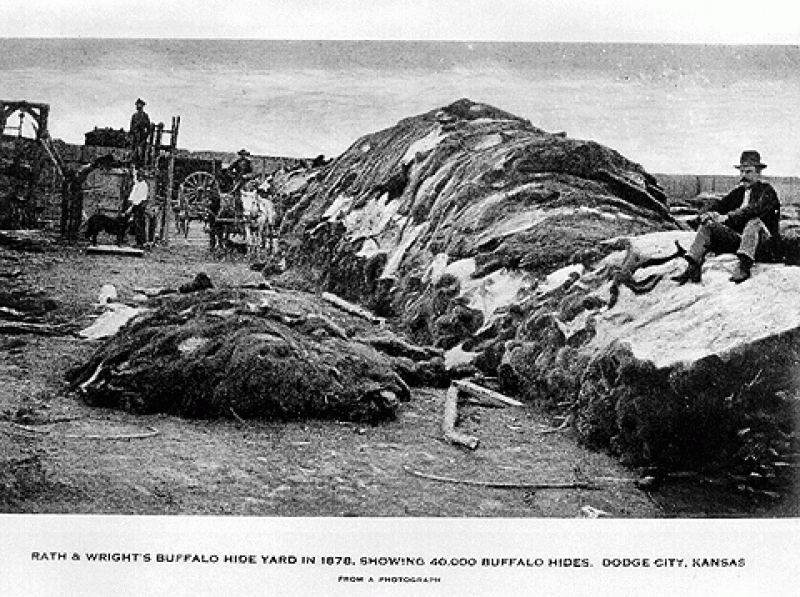Lesson Plan
Core Theme:
Westward Expansion
Grade Level:
5th grade
Estimated Duration:
2-3 + (40 minute class periods)
Objectives:
- Students will be able to interpret primary source documents and begin to understand the relationships among events, places, and people.
- Students will be able to explain how ideas and events from the past have shaped the Western Hemisphere today and impacted the economics of a region.
- Students will be able to explain ‘how where you live influences how you live.
Summary Overview Abstract:
In this lesson plan of primary source activities, students will explore cultural patterns and their interactions, such as land use, settlement patterns and transmission of customs, ideas, and ecosystem changes as they examine photographs of bison/buffalo hides in an attempt to understand the past. They will explore the hunting of bison in the late 1800s and will participate in a debate of the reasons why the hunting took place and their viewpoints whether hunting is ethically and morally acceptable.
Ohio Academic Content Standards:
Theme: Regions and People of the Western Hemisphere
Strand: History
Topic: Human Systems
Content Statement:
7. Variations among physical environments within the Western Hemisphere influence human activities. Human activities also alter the physical environments.
Theme: Regions and People of the Western Hemisphere
Strand: Geography
Topic: Human Systems
Content Statement:
9. Political, environmental, social and economic factors cause people, products, and ideas to move from place to place in the Western Hemisphere today.
Theme: Regions and Places of the Western Hemisphere
Strand: Economics
Topic: Markets
Content Statement:
17. Regions and countries become interdependent when they specialize in what they produce best and then trade with other regions to increase the amount and variety of goods and services available
Primary Source (s) used:
Documents are taken from the following:
Primary Source: Archives of the West, 1868-1874, Rath & Wright's buffalo hide yard, showing 40,000 buffalo hides baled for shipment. Dodge City, Kansas, 1878). https://www.loc.gov/ (Library of Congress)
The following are prints within the Library of Congress:
Sketches in the far West--curing hides and bones
Hu Kalowa Pi-Removes the covering
Indians hunting bison on horses covered with bisonskins
Print speciman of American Indian man on horseback killing bison
Tobacco Advertisement
Materials Needed:
Bison Hide Yard photo from Teacher Created Resources
Five prints from the above website location to be used in small student groups.
One print (Tobacco Advertisement) to be used in whole group discussion
SMARTboard for projection purposes
Photograph Analysis worksheets for the students (, )
Driving Questions:
1. What impact did the hunting of bison have on the American Indian and settler population and the way they lived?
2. How did the hunting of bison change from one of self-consumption to a level of large-scale economically-driven trade business?
3. Was the killing a buffalo/bison purely for consumption and trade purposes or was there an underlying unspoken desire to impact the American Indian population?
Instruction Procedure:
Day 1
Step 1
Pass out copies of the Bison Hide Yard photograph and project it on the SMARTboard, as well for discussion purposes.
Provide a copy of the to each student to view as the teacher walks the students through a sample set of questions pertaining to the .
Ask students to consider the discussion questions on each level of the spiral questions.
Allow several minutes for students to study the photo cards and write responses to the questions on removable sticky notes.
When they are done writing, have each student post his/her responses on the board.
Read each question to the class and share some of the answers from the note sheets.
Guide students through the levels of questions with the initial photograph which all students have in front of them.
Discuss these answers with the class and ask them to consider whether they agree or disagree with the answers and to justify their responses.
Step 2
Share the with students. The completion of the Transcontinental Railroad greatly affected the numbers of bison killed in the American West. Between 1874 and 1878 the great hunt led to the decimation of the southern herd of bison. Some people believe the bison were not only killed to trade in the East, but they were also killed in the hopes of getting rid of American Indians who depended on them for survival.
Have students consider this statement and then have a class discussion/debate. Have half of the class support the theory and the other half oppose it. Students should use the background information page as well as any other classroom resources to support their arguments.
Day 2
Repeat Day 1’s procedures, but this time, have the student groups each take a picture and analyze it according to the . (Formative assessment)
Discuss each photograph as a group and then share out how they responded using the photograph analysis worksheets to guide their responses. Project the following image from the Library of Congress and ask students to make a summation of how pioneers and Native Americans might interpret this illustration:
Buffalo Smoking Tobacco
- Buffalo/bison are strong and mighty beasts. If one would smoke/chew this tobacco, your own strength and vitality would be demonstrated through your actions.
- Discuss advertisements and the influence they have on consumers, even back in the 1800s through this print.
Instructional Procedure: Extension Activities
- Have students debate whether or not the killing of buffalo and bison is ethical in today’s time. Have students debate the killing of animals for the purpose of meat production and what constitutes humane ways of killing agricultural livestock.
- Have students draw pictures of bison and then list all the ways in which they were used by both American Indians and settlers. They should include how each part of the bison was used.
Research how bison were brought back from extinction. Have students find out how bison are protected in America today.

